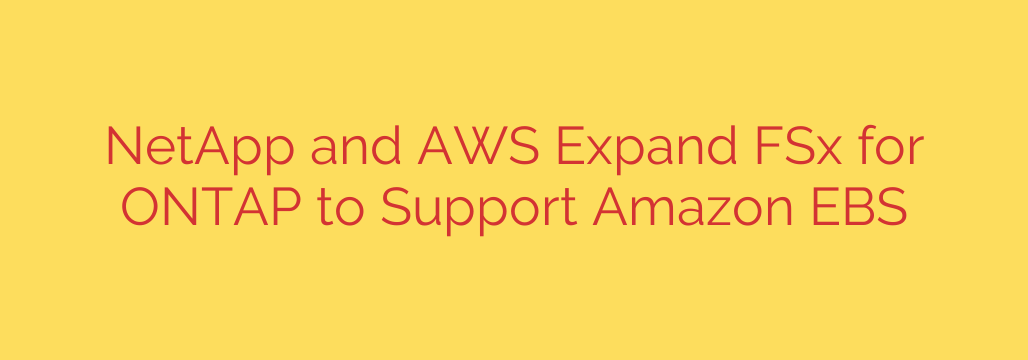
Supercharge Your Cloud Storage: How Amazon EBS Integration Transforms FSx for NetApp ONTAP
In the ever-evolving world of cloud computing, the demand for high-performance, cost-effective, and flexible storage solutions has never been greater. Businesses running mission-critical applications, from high-transaction databases to complex analytics workloads, require storage that can keep pace without breaking the budget. A significant enhancement in the cloud storage landscape now addresses this challenge head-on, delivering a new level of power and control to users of Amazon FSx for NetApp ONTAP.
Amazon FSx for NetApp ONTAP has been enhanced to support Amazon Elastic Block Store (EBS) for its primary SSD storage tier. This integration marks a pivotal moment for cloud architects and IT managers, unlocking unprecedented capabilities for managing enterprise data in the cloud.
A New Era of Flexibility and Performance
At its core, Amazon FSx for NetApp ONTAP provides fully managed, feature-rich file storage built on NetApp’s popular ONTAP file system. It already offers powerful data management features like snapshots, cloning, and replication. However, the addition of EBS support fundamentally changes how performance and capacity are managed.
Previously, the performance of an FSx for ONTAP file system was tied to its SSD capacity. To get more performance (measured in IOPS and throughput), you had to provision more storage, which could lead to paying for capacity you didn’t need.
With this new integration, you can now independently scale performance and capacity. This means you can provision a high-performance SSD tier using specific Amazon EBS volume types—like gp3 or io2 Block Express—to meet your exact IOPS and throughput requirements, without overprovisioning storage space.
Key Benefits of Using EBS with FSx for ONTAP
This new capability delivers several game-changing advantages for organizations running demanding workloads on AWS.
1. Granular Performance Control
You are no longer locked into a fixed performance-to-capacity ratio. Instead, you can precisely dial in the performance your application needs.
- Higher IOPS: Provision file systems with up to 256,000 IOPS and up to 4 GB/s of throughput per file system, ideal for latency-sensitive applications.
- Tailored Performance: Choose the EBS volume type (like General Purpose SSD gp3 or Provisioned IOPS SSD io2) that best matches your workload’s profile, whether it’s for virtual desktop infrastructure (VDI), electronic design automation (EDA), or relational databases.
2. Significant Cost Optimization
By decoupling performance from capacity, you can build highly cost-effective storage solutions. If your application requires high IOPS but has a relatively small data footprint, you can provision for high performance without paying for terabytes of unused SSD space. This “right-sizing” capability ensures you only pay for the resources you actively use, leading to substantial cost savings.
3. Expanded Use Cases for Demanding Workloads
The enhanced performance opens the door for a wider range of enterprise applications to run seamlessly on FSx for ONTAP. This is especially beneficial for:
- High-Performance Databases: Workloads like Oracle, SAP HANA, and Microsoft SQL Server that demand consistent, low-latency performance can now be confidently migrated and run.
- Media and Entertainment: Video rendering and content delivery workflows that require high throughput can leverage this enhanced speed.
- Data Analytics: Big data and analytics platforms that process large datasets will see a significant boost in processing times.
How It Works: A Look Under the Hood
When creating a new Amazon FSx for NetApp ONTAP file system, you now have the option to provision your primary SSD storage with a specified level of IOPS. Behind the scenes, AWS provisions the appropriate Amazon EBS volumes to deliver that performance target.
This primary SSD tier serves as a high-speed cache, while less frequently accessed data can be automatically tiered to a lower-cost, elastic capacity pool built on Amazon S3. This intelligent tiering, combined with the new high-performance EBS option, creates a perfectly balanced system for both speed and cost efficiency.
Actionable Security and Management Tips
As you explore this powerful new feature, it’s crucial to maintain strong security and governance practices.
- Leverage IAM Policies: Use AWS Identity and Access Management (IAM) to enforce the principle of least privilege. Ensure only authorized users and services have permission to create, modify, or delete your file systems.
- Utilize VPC Security Groups: Configure your Virtual Private Cloud (VPC) security groups and network ACLs to act as a virtual firewall, controlling inbound and outbound traffic to your FSx for ONTAP file systems.
- Enable Encryption: Always use encryption for data both in transit and at rest. FSx for ONTAP supports AWS Key Management Service (KMS) for encrypting your data, giving you centralized control over your encryption keys.
- Monitor and Audit: Use Amazon CloudWatch to monitor performance metrics and set alarms for key thresholds. Enable AWS CloudTrail to log all API activity related to your file systems for security auditing and compliance.
The Future is Fast and Flexible
The integration of Amazon EBS with Amazon FSx for NetApp ONTAP is more than just an update—it’s a fundamental enhancement that redefines what’s possible with cloud file storage. By providing granular control over performance, enabling significant cost optimization, and supporting the most demanding enterprise workloads, this development empowers businesses to build faster, more efficient, and more flexible cloud data architectures.
Source: https://datacenternews.asia/story/netapp-aws-extend-fsx-for-ontap-support-to-amazon-evs








